Where else,” wondered tobacco harm reduction advocate David Sweanor, “do we permit a really deadly product, but try to restrict access to safer ones?”
Delegates at the Global Forum on Nicotine (GFN) in Warsaw from June 13-15 were left in no doubt of the scale of challenges facing tobacco harm reduction (THR). Despite the potential of safer nicotine delivery to save more human lives than any other harm reduction initiative, the hostility, lies and bad policies—from punitive taxation to severe restrictions to outright bans—being aimed at THR are daunting.
“The death of truth is very real,” said Sweanor, who is chair of the advisory board of the University of Ottowa’s Centre for Health Law, Policy and Ethics. “Not just in the US—but the US has certainly taken a huge lead.”
“In Australia, we have appalling laws about nicotine delivery,” said politician Fiona Patten, leader of the country’s Reason party. “Our reduction in smoking is pretty much stagnating. When I ask the minister of health about vaping regulation, I get told that vapes are ‘a gateway for children’, that they ‘renormalize smoking.’”
As harm reductionists have long known, much opposition is fundamentally due to narrow-minded tenets about what is and isn’t acceptable for other people to do. “We know that it’s not arguments about facts and evidence,” said Professor Gerry Stimson, director of GFN host organization Knowledge Action Change* and a veteran of harm reduction responses to HIV/AIDS. “It runs much deeper than that.”
“For the first time in 120 years, we could eliminate the death and disease caused by the cigarette rolling machine.”
GFN was a diverse gathering of 600 delegates—directly impacted people, advocates and activists, scientists, clinicians and social workers, and industry representatives, who also attended an accompanying tech convention—from 70 countries on every continent except Antarctica. Scores of international journalists also attended the annual event—the biggest yet, which speaks to the movement’s forward momentum.
While climbing a mountain, as Sweanor pointed out, the peak may seem miles away, but you also have to turn around sometimes and look at how far you’ve come. The fact that millions of smokers have already switched to exponentially safer vaping or non-combusted forms of tobacco—to vapes in the UK, for example, to snus in Scandinavia, or to heat-not-burn devices in Japan and South Korea—is to be celebrated.
“For the first time in 120 years,” Professor David Abrams of the NYU College of Global Public Health reminded us, “we could eliminate the death and disease caused by the cigarette rolling machine—and I believe we will.”
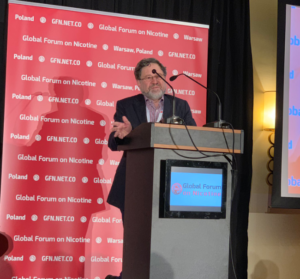 David Abrams speaks at GFN
David Abrams speaks at GFN
But with a billion people still smoking worldwide, the barriers to giving them safer choices remain pernicious and pervasive.
Almost everywhere you look, “Think of the children” is the politicians’ and public health establishment’s refrain, as Eveline Hondius of Dutch vaping consumer group Acvoda expressed. The well-worn phrase is familiar to those who have campaigned for cannabis legalization, for example.
“They have used the kids issue absolutely ruthlessly,” said Clive Bates, THR advocate and former director of Action on Smoking and Health (ASH). “Essentially where they’re heading is to treat harm reduction products exactly the same as combustible tobacco. And I hate to say that they’re doing quite well with that agenda.”
“This is a battle we’re losing, and losing badly,” said Dr. Saul Shiffman, a researcher and senior scientific advisor at Pinney Associates. “We’re being outplayed in the US.”
Joseph Magero from Kenya, who is chair of Africa’s Campaign for Safer Alternatives, described problems including ostracization from the public health and tobacco control community, lack of funding and lack of locally applicable research.
In Africa, he said, “The World Health Organization and the Campaign for Tobacco-Free Kids [two organizations that have significantly opposed THR] decide in matters of regulation.”
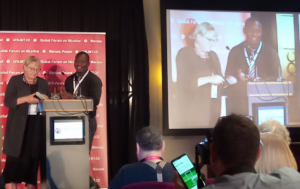 Joseph Magero receives an Outstanding Advocacy award in Warsaw (Photo via THR Nigeria)
Joseph Magero receives an Outstanding Advocacy award in Warsaw (Photo via THR Nigeria)
These challenges are mirrored by those of advocates from Mexico to India who spoke at GFN—all as 7 million people continue to die annually from smoking-related causes.
Science Strikes Back
The THR cause is bolstered by the work of many scientists, a number of whom spoke in Warsaw.
“We have massive evidence now that giving nicotine to smokers can help them—over 130 randomized controlled trials,” said Professor Peter Hajek of the Wolfson Institute of Preventive Medicine’s Tobacco Dependence Research Unit at Queen Mary University of London. His own work showed this year that vaping is nearly twice as effective as traditional nicotine replacement therapy, like patches or gum, in helping smokers quit.
“We have a lot of literature on snus, and by-and-large snus has been shown to be not very harmful,” added Professor Neal Benowitz of the departments of Medicine, Biopharmaceutical Sciences, Psychiatry, and Clinical Pharmacy at UCSF, while also cautioning of the need for more research into long-term outcomes of inhaled nicotine products.
At the same time, “Junk science is escalating,” said Professor Riccardo Polosa of the University of Catania, Italy, who also runs the Center of Excellence for the Acceleration of Harm Reduction. He decried widespread methodological flaws and lack of rigor in studies that are deployed against THR, declaring, “We can make tobacco harm reduction research credible again.”
Some heavyweight researchers lined up to debunk the “junk.” Dr. Konstantinos Farsalinos, a research fellow at the Onassis Cardiac Surgery Center in Greece among other institutions, analyzed how, in the media-fanned “epidemic” of US teen vaping, daily use among youth who have never smoked stands at the decidedly non-epidemic level of 0.5 percent.
Dr. Roberto Sussman, a researcher and lecturer in physics at the National University of Mexico who also runs the advocacy organization Pro-Vapeo Mexico, deconstructed alarmist claims about the particles produced by secondhand vapor—suggesting that if we must have a moral panic, it might be more rational to apply it to candles or vacuum cleaners.
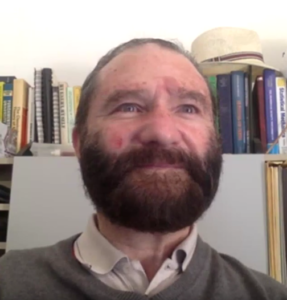
Roberto Sussman in an interview (Photo via GFN)
The People, the People, the People
Yet for all the importance of the scientific evidence underpinning THR, advocate Samrat Chowdhery, who leads Association of Vapers India, noted that quite often, “research simply validates what consumers already know to be true.”
And as Prof. Abrams declared: “It’s about the people, the people, the people.”
GFN heard from many who conduct groundbreaking research or hands-on tobacco harm reduction delivery with the marginalized, low-income groups who smoke at far higher rates than the general population—the people who will be harmed the most if we fail to drive policy forward.
“This group isn’t hard to reach. We’re just not reaching out.”
“Tobacco harm reduction is a social justice issue,” declared Professor Kevin McGirr of the UCSF School of Nursing.
“Empower people to lead,” exhorted Rebecca Ruwhiu-Collins of her holistic THR work in her Māori community, which she said has been “decimated” by smoking harms.
“The most important group to do research in is pregnant women who smoke,” said Dr. Marewa Glover, whose work also centers on Indigenous populations.
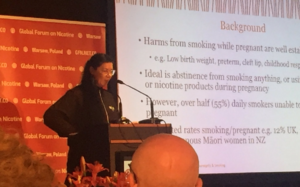
Marewa Glover (photo via Addiction Research UAE)
“People take part,” said Dr. Sharon Cox of London South Bank University’s Centre for Addictive Behaviours Research, who is conducting research focused on THR for homeless populations. “This group isn’t hard to reach. We’re just not reaching out.”
“People with serious mental illness don’t live long enough to get cancer,” said Dr. Sarah Pratt, a clinical psychologist and an assistant professor of Psychiatry at Dartmouth University’s Geisel School of Medicine. “They die of [smoking-related] heart attack and stroke.”
She also reminded delegates: “It’s great to listen to so many smart people here, but what we all need to do more of is listen to consumers, listen to members of these vulnerable populations.”
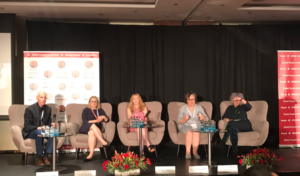
A plenary session on vulnerable populations with Kevin McGirr, Sharon Cox, Sarah Pratt, Rebecca Ruwhiu-Collins and Deborah Robson. (Photo via Fiona Patten)
With the clock ticking on too many lives, there’s huge pressure on THR advocates to deliver. Clive Bates’s advocacy tips included: “Get organized” and build networks; “Don’t be too clever, but communicate your lived experience;” and “Be inclusive: You are not in competition with people on the same side as you … be advocates for the entire category of non-combustible products, rather than highlighting differences between them.”
“Money talks,” stressed Fiona Patten of Reason. “If you can talk about the health economics of new nicotine delivery systems … particularly for conservatives, it is those messages that can work.”
The need for THR to learn from the winning strategies of the wider harm reduction movement was another point made by many.
When it comes to politicians and officials who refuse to recognize THR’s massive potential to save lives, suggested David Sweanor: “Challenge them, ridicule them, get people to laugh at them is what’s necessary.”
GFN 2019 was a powerful display of the fast-growing scale, drive, talents and diversity of the tobacco harm reduction movement. With many enemies, the movement’s ability to effectively leverage all of these things is something that Filter will follow closely over the coming year.
*Knowledge Action Change has previously funded The Influence Foundation, which operates Filter, through a scholarship.
Top photograph via Global Forum on Nicotine
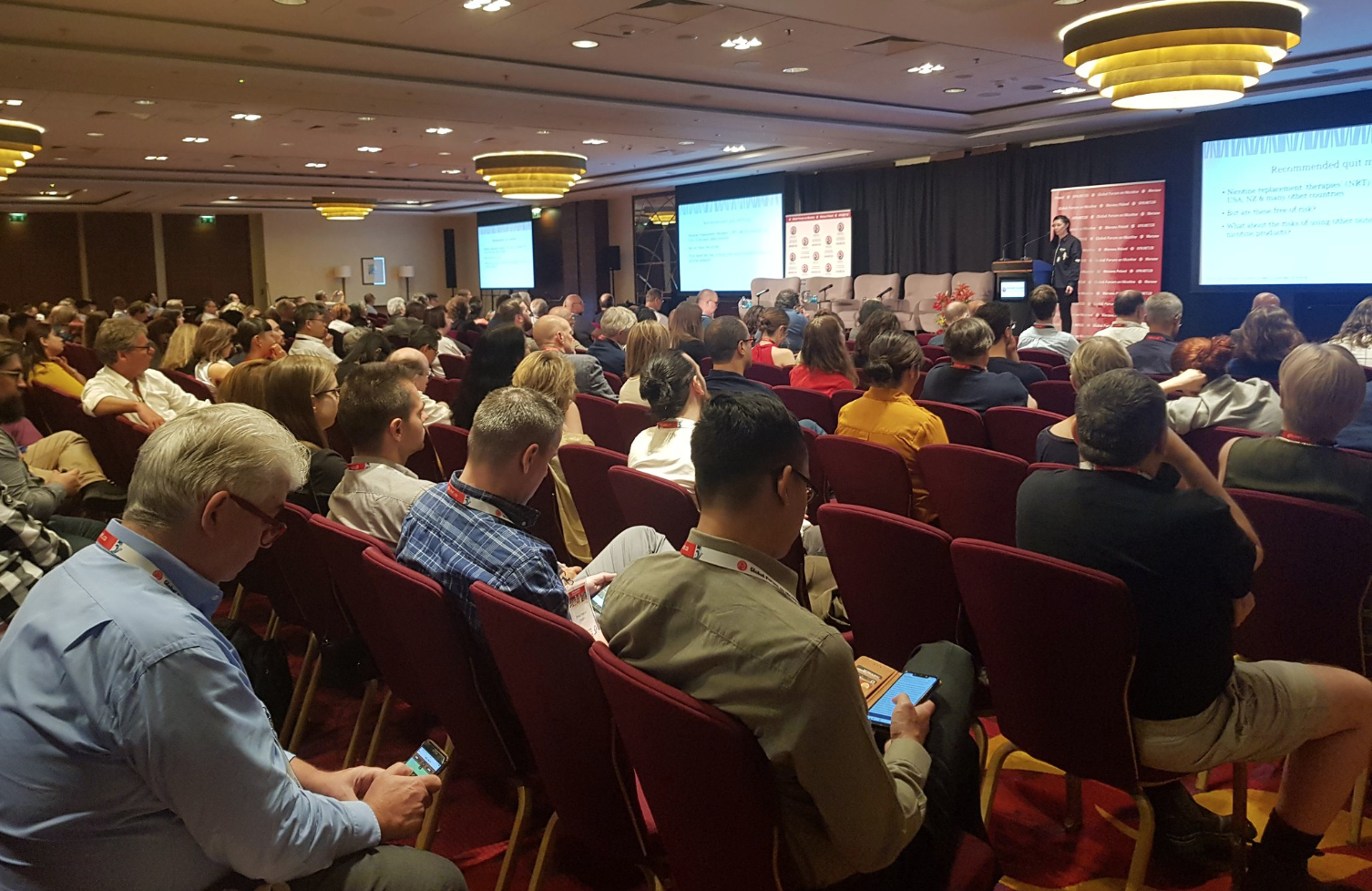




Show Comments